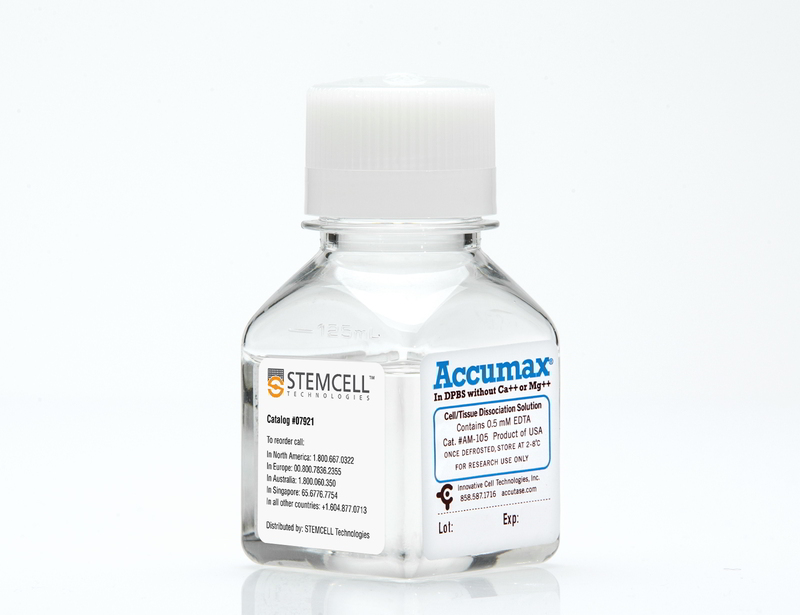ACCUMAX™
Cell detachment solution
概要
ACCUMAX™ is a cell detachment solution of proteolytic and collagenolytic enzymes. It is useful for creating single-cell suspensions from clumped cell cultures for accurate cell counting, detachment of cells from primary tissue, and the routine detachment of cells from standard tissue culture plasticware and adhesion-coated plasticware. ACCUMAX™ does not contain mammalian- or bacterial-derived products.
Each lot of ACCUMAX™ is tested for sterility (by USP membrane filtration method), enzymatic activity (tested with synthetic chromagenic tetrapeptides), and cell detachment from tissue culture plastic.
Each lot of ACCUMAX™ is tested for sterility (by USP membrane filtration method), enzymatic activity (tested with synthetic chromagenic tetrapeptides), and cell detachment from tissue culture plastic.
Contains
• 1X ACCUMAX™ enzymes in Dulbecco’s phosphate-buffered saline (D-PBS)
• 0.5 mM EDTA•4Na
• 0.5 mM EDTA•4Na
Subtype
Enzymatic
Cell Type
Pluripotent Stem Cells
Species
Human, Mouse, Rat, Non-Human Primate, Other
Area of Interest
Stem Cell Biology
技术资料
| Document Type | 产品名称 | Catalog # | Lot # | 语言 |
|---|---|---|---|---|
| Product Information Sheet | ACCUMAX™ | 07921 | All | English |
| Safety Data Sheet | ACCUMAX™ | 07921 | All | English |
数据及文献
Publications (1)
Stem cells (Dayton, Ohio) 2015 DEC
Transcriptome Dynamics of Developing Photoreceptors in Three-Dimensional Retina Cultures Recapitulates Temporal Sequence of Human Cone and Rod Differentiation Revealing Cell Surface Markers and Gene Networks.
Abstract
Abstract
The derivation of three-dimensional (3D) stratified neural retina from pluripotent stem cells has permitted investigations of human photoreceptors. We have generated a H9 human embryonic stem cell subclone that carries a green fluorescent protein (GFP) reporter under the control of the promoter of cone-rod homeobox (CRX), an established marker of postmitotic photoreceptor precursors. The CRXp-GFP reporter replicates endogenous CRX expression in vitro when the H9 subclone is induced to form self-organizing 3D retina-like tissue. At day 37, CRX+ photoreceptors appear in the basal or middle part of neural retina and migrate to apical side by day 67. Temporal and spatial patterns of retinal cell type markers recapitulate the predicted sequence of development. Cone gene expression is concomitant with CRX, whereas rod differentiation factor neural retina leucine zipper protein (NRL) is first observed at day 67. At day 90, robust expression of NRL and its target nuclear receptor NR2E3 is evident in many CRX+ cells, while minimal S-opsin and no rhodopsin or L/M-opsin is present. The transcriptome profile, by RNA-seq, of developing human photoreceptors is remarkably concordant with mRNA and immunohistochemistry data available for human fetal retina although many targets of CRX, including phototransduction genes, exhibit a significant delay in expression. We report on temporal changes in gene signatures, including expression of cell surface markers and transcription factors; these expression changes should assist in isolation of photoreceptors at distinct stages of differentiation and in delineating coexpression networks. Our studies establish the first global expression database of developing human photoreceptors, providing a reference map for functional studies in retinal cultures.


